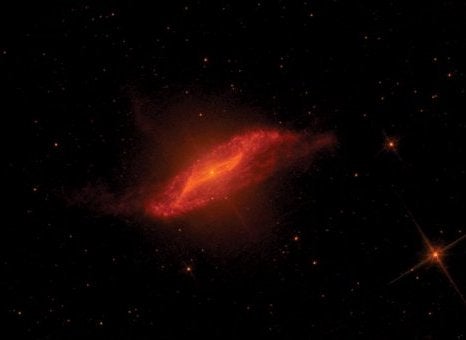The dusty remnant of a spiral galaxy’s disk lies warped and twisted in the heart of the giant elliptical galaxy (and bright radio source) known as Centaurus A (NGC 5128). The dusty disk was discovered by a group of astronomers headed by Jocelyn Keene (Jet Propulsion Laboratory) using the infrared-sensitive Spitzer Space Telescope. Keene announced the finding at the June meeting of the American Astronomical Society in Denver.
Cen A lies some 14 million light-years away; in visible light, it shows a dark, enigmatic band crossing its middle. Spitzer’s Infrared Array Camera (IRAC) looked past the galaxy’s visible parts and found the geometrically twisted sheet of dust deep inside.
“The IRAC instrument can look right into and even through Cen A,” says Keene. This allowed her to take unprecedented, detailed images showing the dust, which resembles a tangled and twisted sheet. This sheet appears brighter where its wrinkles lie edge-on to our line of sight, and its parallelogram appearance gave Keene’s team the clues they needed to model how gas dynamics and tidal forces molded its shape.
The most likely source of the dust is a spiral galaxy that drifted into Cen A’s gravitational grip. “The collision occurred about 200 million years ago,” says Keene. She proposes that the former spiral galaxy’s older stars have been grafted onto the outer parts of Cen A, while the dust and gas in the spiral’s disk sank into the center of the big galaxy. Ultimately, the spiral’s leftovers will be completely absorbed by Cen A.
This huge elliptical galaxy is one of the most powerful radio sources in the sky, which astronomers attribute to the effects of a supermassive black hole with the mass of 100 million suns in Cen A’s core. Matter swirling around the black hole becomes heated to extremely high temperatures before disappearing over the black hole’s event horizon. Astronomers think Cen A grew by swallowing smaller galaxies in just this fashion.










